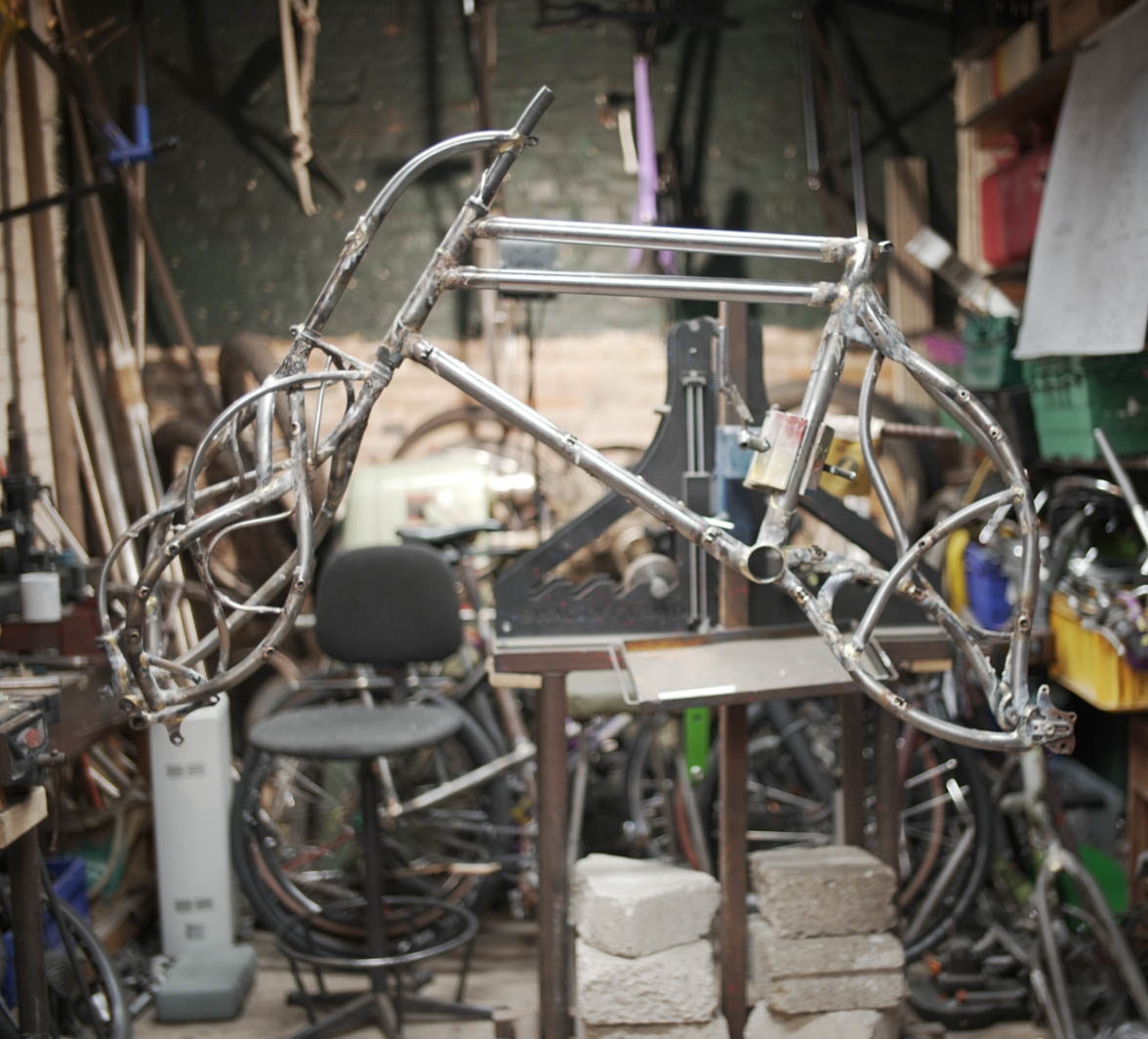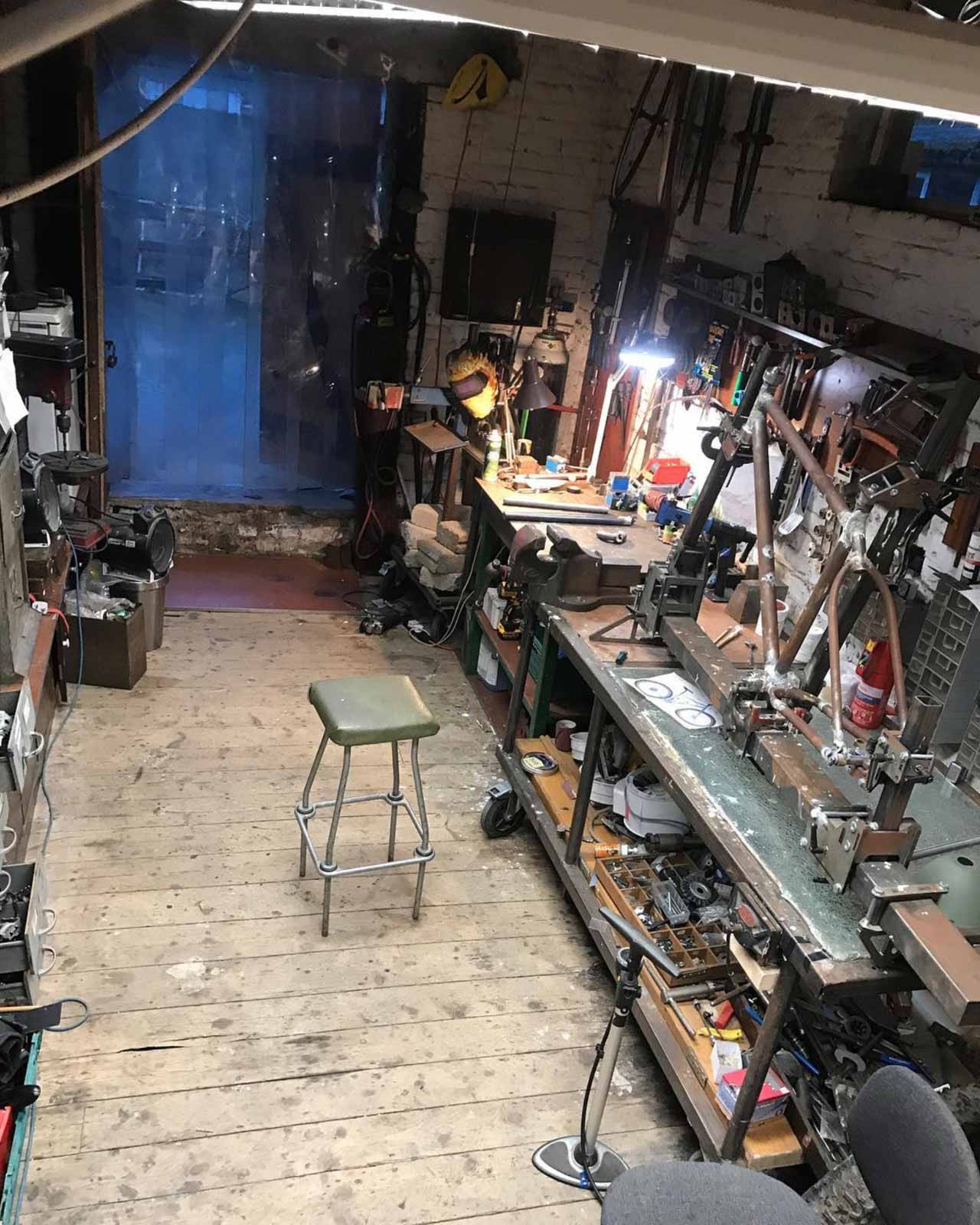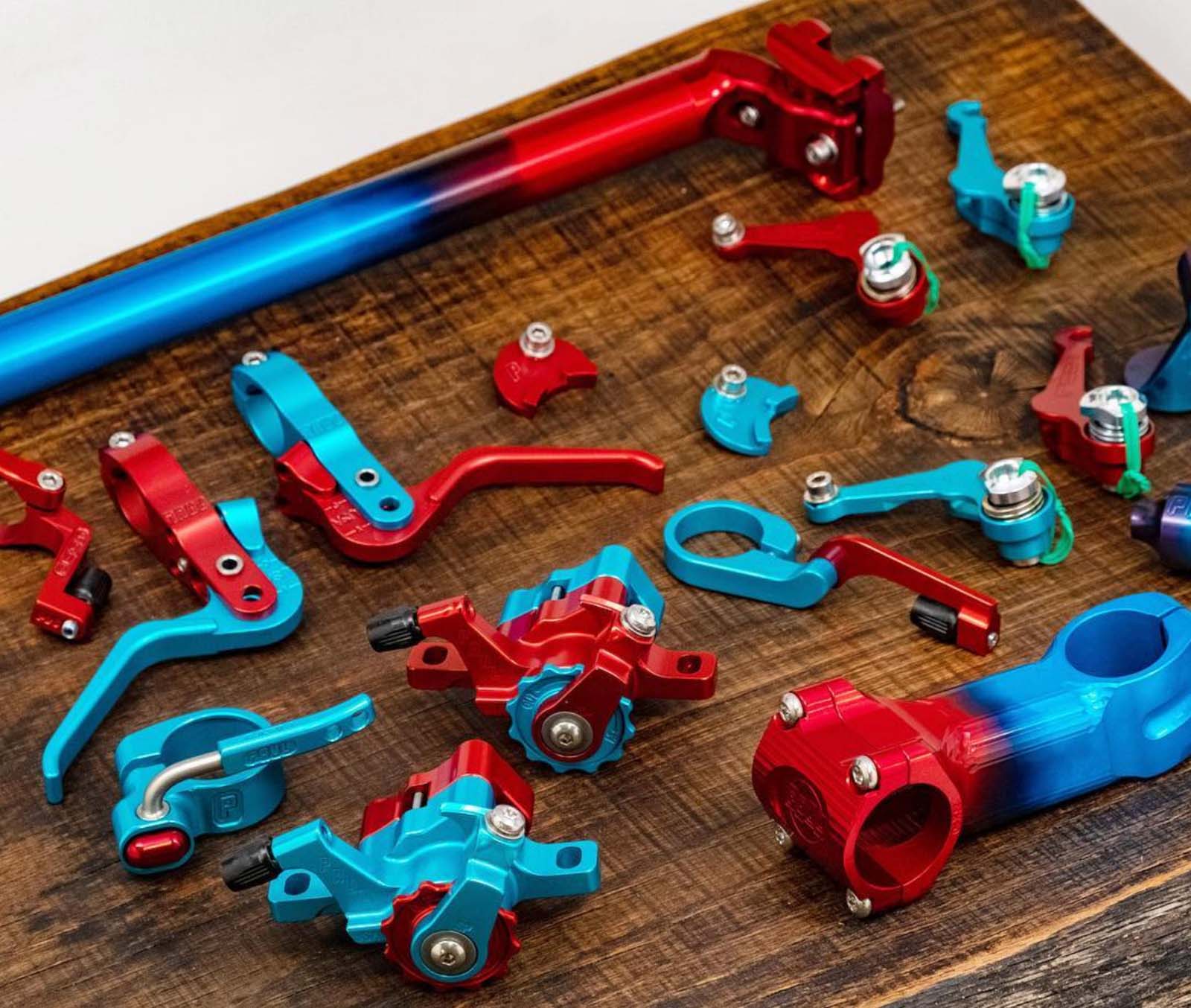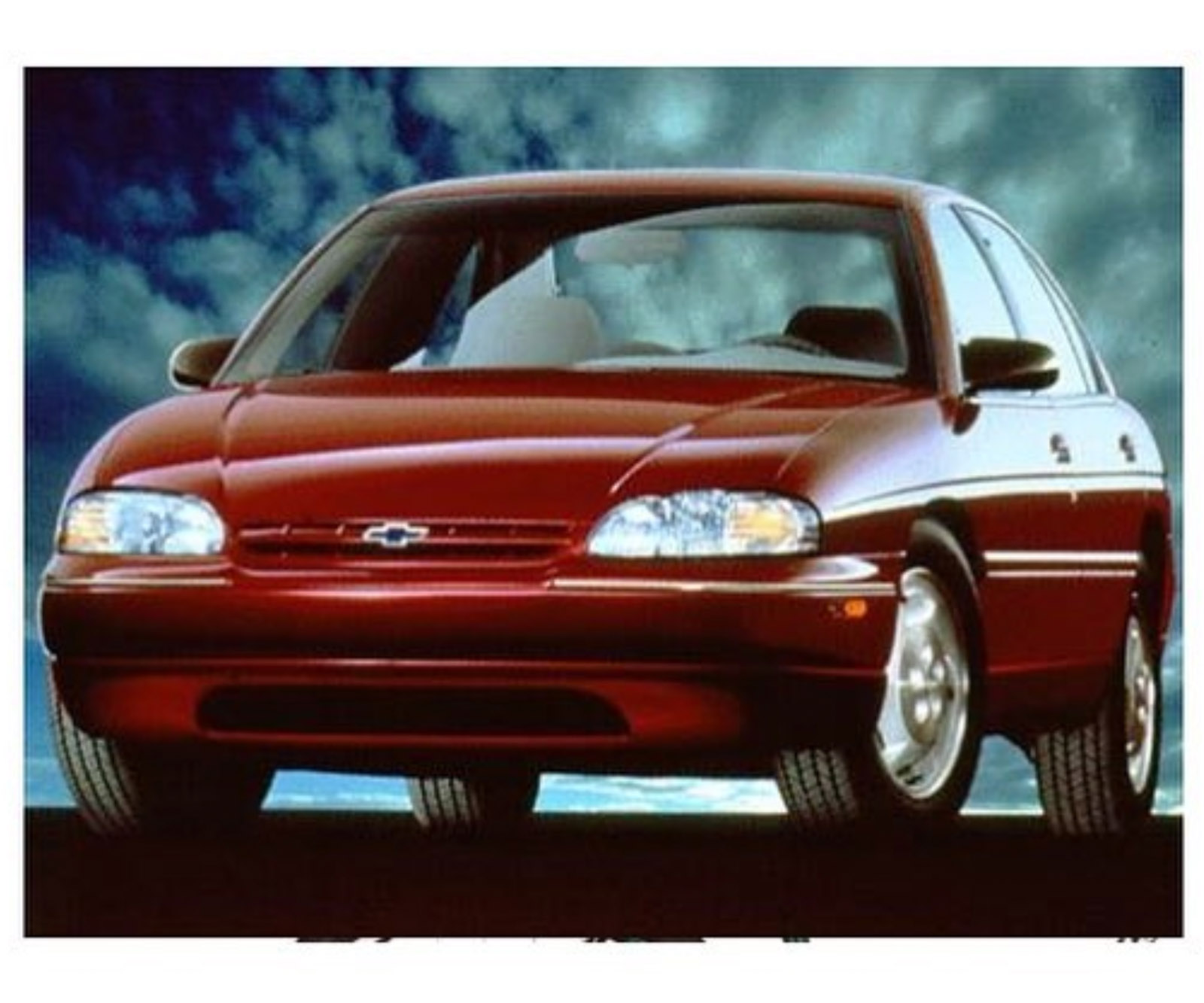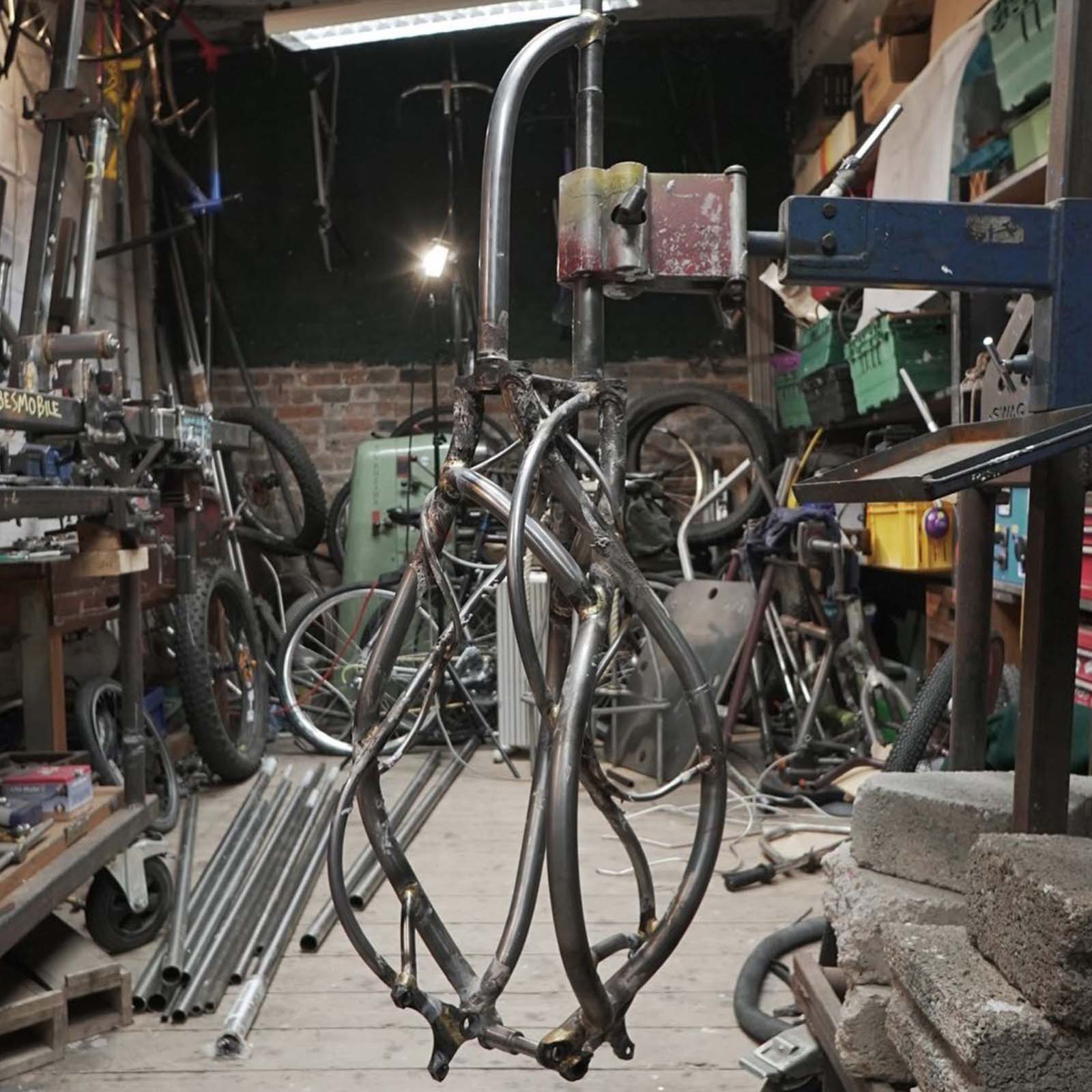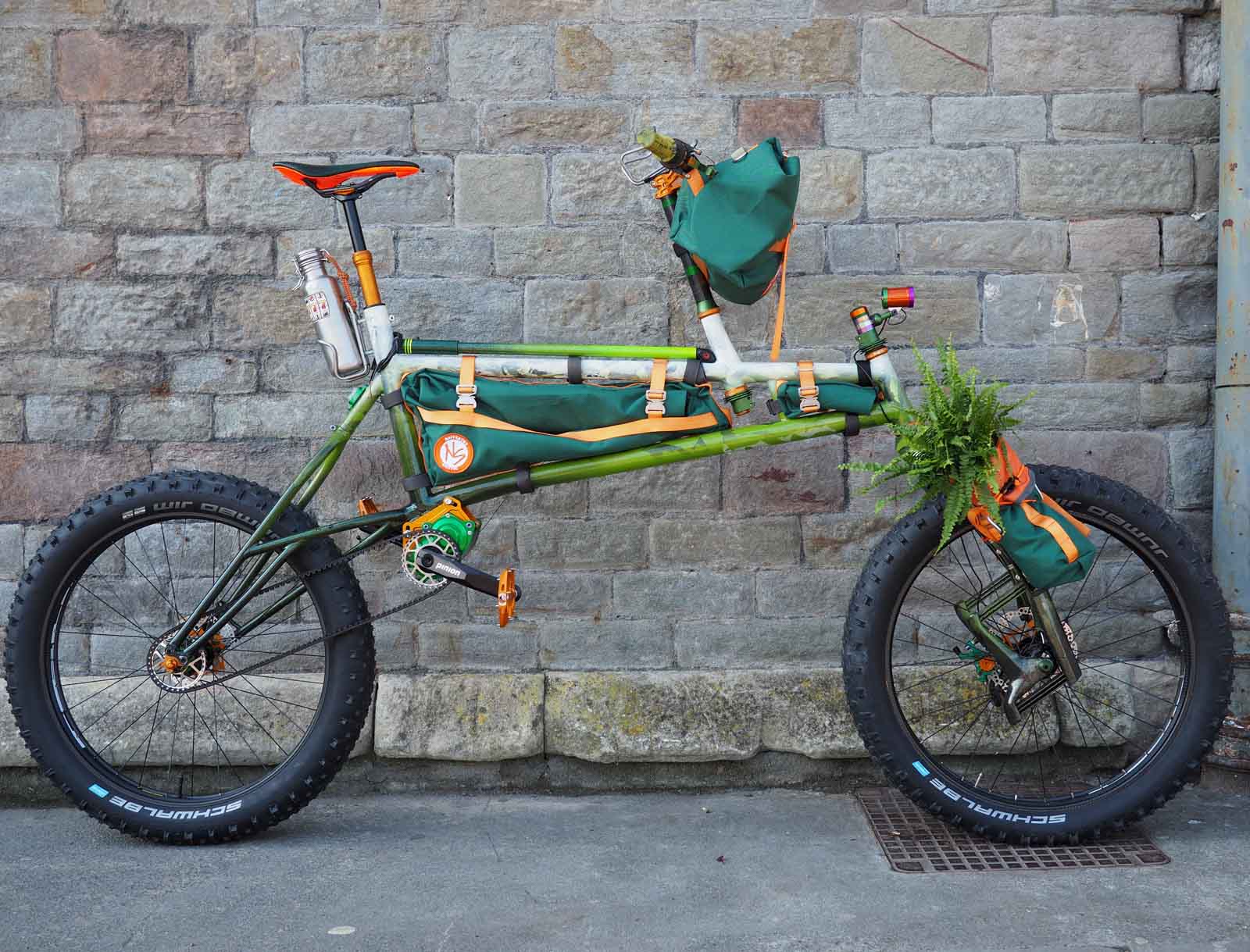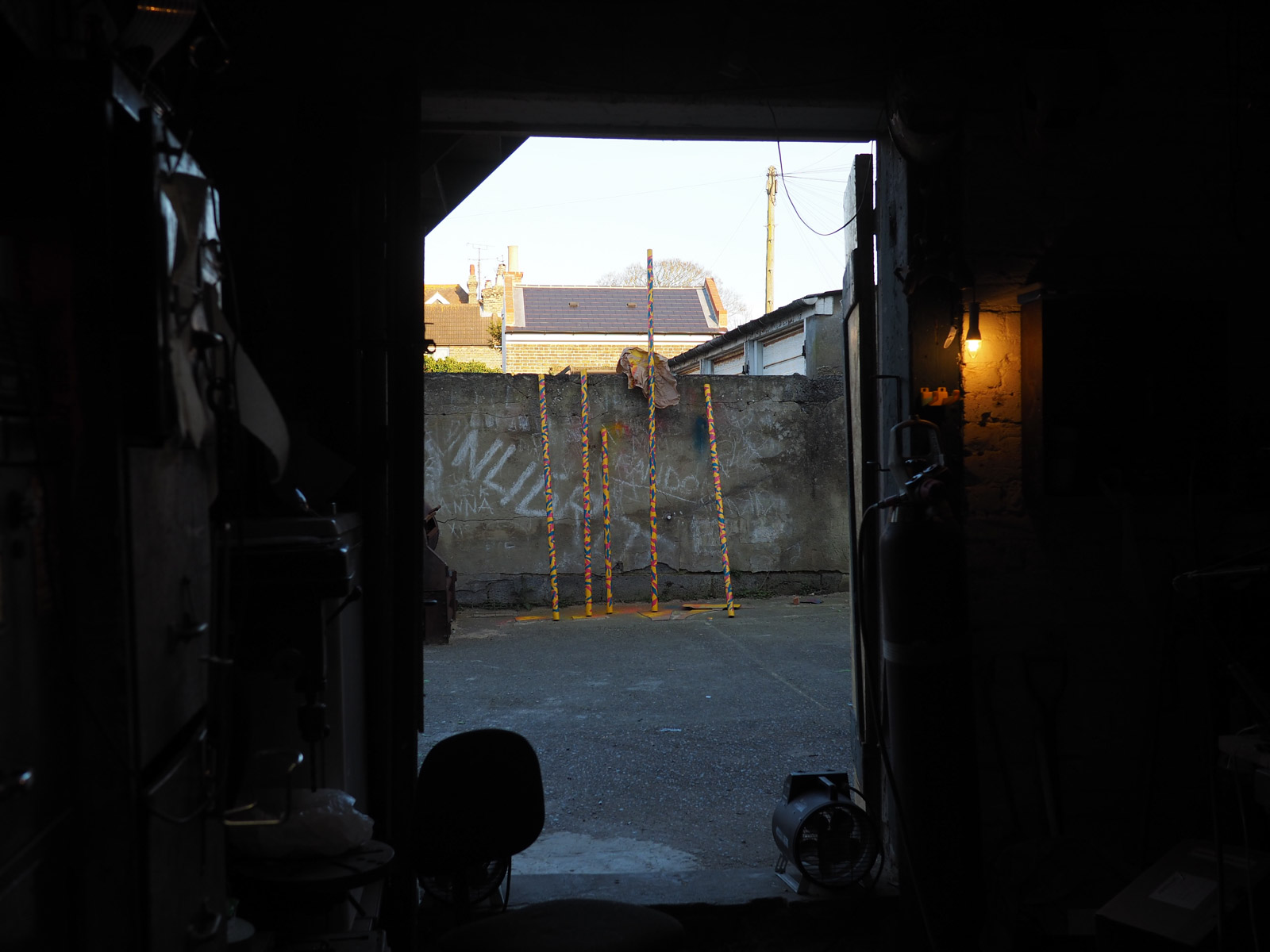If you missed yesterday’s installment, you can read about Petor’s origin story and his hesitancy around duck sponge throwing here. Take a minute or two and catch up. I promise that it will make this part of the interview much richer.
Now that you’ve met Petor and have gained a bit of understanding of how he ticks, we can properly frame so you can fully appreciate the frenzied fever-dream that is the PUBESMOBILE.
Without further ado, the thrilling interview conclusion:

ANNA: You’re coming to NAHBS with something called the PUBESMOBILE. What’s the story?
PETOR: I followed Bicycle Pubes for awhile when there was no one following Bicycle Pubes. When it was 70 people. “Who is this guy? He’s so en pointe all of the time.” Then he did that interview with Craig Calfee and I was like, holy mother of god, he’s a genius!
ANNA: How did the bike come about?
PETOR: To be honest, I always thought about NAHBS as an unreachable goal. It’s still not real. It’s not even NAHBS for me – for me this is a pilgrimage. This is so much more than NAHBS. What I’m really excited about is meeting people outside of NAHBS. Meeting people’s whose work I’ve known for a really long time. I don’t feel like I’m on that same platform but, because I’ll be there, I kind of will be.
When Chris King came for Bespoked the first time, the only thing that I could think to say that came out of my mouth was, “You are actual Chris actual King.”
He was like, “Uh, yeah.”
“… and that’s you.’
“…yes.”
“Oh my god.”
I couldn’t even say anything to him.
ANNA: Aw. You’re going to have so much fun at NAHBS. So you’re coming to this show that’s unattainable – except it is attainable. You’re coming, basically.
PETOR: Basically is a good way of putting it. I’ve got plane tickets. I have travel insurance. Oh, and two bikes.
ANNA: Talk about this Pubes bike – who started it?
PETOR: I can’t remember. I think you were there at the time. It happened at Bespoked last year. This has been on the cards for a year. I vaguely had a conversation with Gareth from Spray.Bike about going to NAHBS. If I got to NAHBS, I could be in the Spray.Bike booth.
About five minutes after that conversation I sent an Instagram message, “Hey, I’m coming to NAHBS, I want to build a Bicycle Pubes bike!”
ANNA: What is the bike? What is it the way it is?
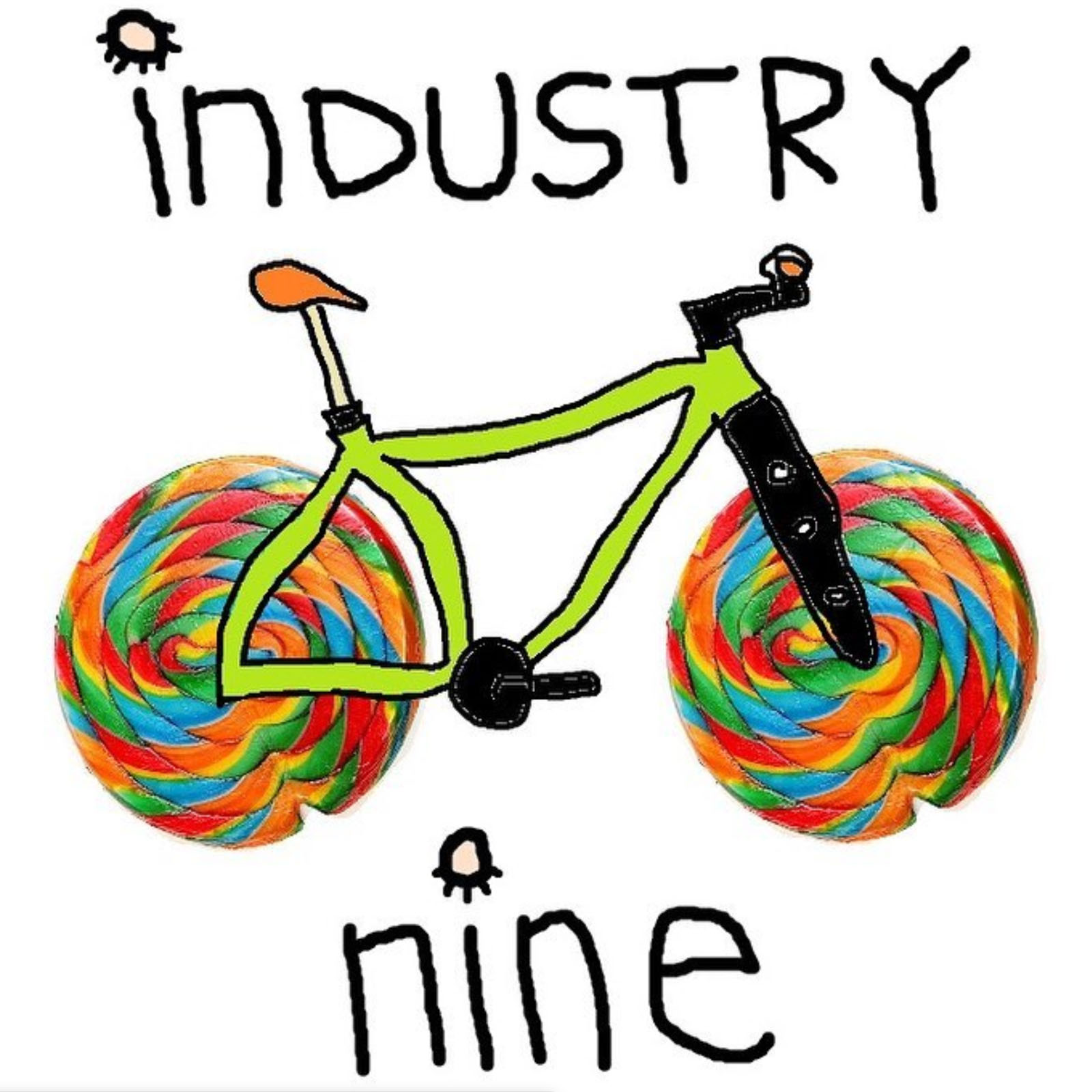
PETOR: We did a competition of what it would be. I did really like the idea of that, someone coming up with some dumb shit and having to make it real. That’s a fun challenge. But then I got too involved. I guess instead of taking any value at face value, I picked out bits that were most in the spirit of Bicycle Pubes. In the same way as Bicycle Pubes’ thing is: See a dumb thing, make it so much more extreme, and then make fun of it…
ANNA: Yes, yes that is his model.
PETOR: I thought, “I’m going to take that, make THAT so much more extreme, and then make fun of that.”
What’s that game? Where you draw a head and then fold the piece of paper, and then the next person has to draw the body and then you fold the paper and the next person has to draw the legs? It’s like that, but I think I got too into it.
It’s like whenever I get to this point of despair where it’s like, I think the bicycle industry eats its own babies and UK eats its own babies and it’s like life just eats its own babies and I might as well just lay down and die now… and then someone pops up and is just so kind and so generous that it restores your faith in the whole thing? Mark from Paragon Machine Works was that person.
Really early on I’d just talk to people I knew about it, and they would be like, “That’s literally the dumbest thing I’ve ever heard,” in a serious way, not a fun way. “What’s wrong with you?” I really wish I knew the answer to that question.
But then Mark was like, “I AM SO FULLY BEHIND THIS: AND WILL ENDORSE IT IN ANY WAY POSSIBLE.”
I have so much respect for Mark. What he makes is ACTUALLY amazing. Why is he behind what I am making? It doesn’t make any sense to me. That’s why this trip is so amazing for me. Because I get to hang out with Mark from Paragon Machine Works and Paul from PAUL Components and Paul Sadoff and Steve Potts – people who from the very beginning of getting into cycling were making the really cool shit.
ANNA: Were you a fan of the US frame building contingency from before you were a builder?
PETOR: Yeah! I definitely was! I was definitely a PAUL fan from forever – Paul’s stuff growing up was the most exotic shit that I didn’t even know why it was amazing but it was amazing. When I was at the Bicycle Academy when it first started, they just had drawers with frame components in them. You’d dig through a drawer of dropouts – it was like a sweetshop. All the stuff I picked was Paragon stuff because it’s really nicely made, really well designed stuff.
Mark being really on-board with this project was just the biggest thing for me, really. All the frame parts on the PUBESMOBILE came from Paragon. The Bicycle Academy supported us with all the tubes. James from Black Sheep has made us some custom handlebars and a custom titanium quill stem –
ANNA: PAUL did some beautiful custom parts for you.
PETOR: Yeah! Having support from these people – support from PAUL, from Industry Nine –
ANNA: Let’s talk about the bike. Specifically this fork. What is this fork?
PETOR: So Pubesy was like, “Can we have a truss fork on the front and the back.”
“Man, I don’t know, truss forks are a lot of work.” I just didn’t know if I was going to be able to afford the time to do a truss fork on the front and the back.
But then we got support from the Bicycle Academy and it was like “Hell yeah! We’re going to have truss forks EVERYWHERE!”
There was a particular picture on the Bicycle Pubes thing where there was an Oddity with a knot in the top tube. “I’m going to do it! I’m going to make a knot!” It ended up being very heavy.
I kind of hate symmetrical. Bikes are not symmetrical, so why pretend? There’s a drive side and a non-drive side. I definitely went through a phase where it was like symmetry is everything and I built a track bike with two drive sides, so it would be symmetrical.
ANNA: A lot of people have come together.
PETOR: Yeah. The support for this has been absolutely mind blowing. It’s not even people supporting me building this thing – it’s people who I really respect supporting me in doing anything.
ANNA: It’s not a simple bike.
PETOR: Oh no. That fork – I wish I’d just tied a knot in the top tube. That fork took me like four days. They weren’t even normal 9 to 5 days – it was Rosie asking me why I don’t come home anymore. It was a long four days. The four main legs took ages to work out because they are lugged – making it lugged was a poor decision. There’s a Chevy Lumina on it.
PETOR: When I got the money for the bike, I did have a panic. I was like, maybe, with this money, I should hold onto it until I get to America and then buy a 1998 Chevy Lumina and then just paint that with the Spray.Bike, and drive it to the bike show, and tell everyone it’s an electric bike.
ANNA: That would have been absolutely epic. I’m glad you didn’t, though.
PETOR: Me too. Well, the thing that made me not was Mark.
ANNA: How did you align this thing?
PETOR: Oh, you know, just throw it on a jig.
ANNA: It’s bananas. How did you make sure it was kept aligned? Especially it being so structurally asymmetrical.
PETOR: If your miters are really tight, stuff doesn’t move much, and you braze logically, taking it in turns so everything is staying straight.
ANNA: I’m looking at the fork now. Miters everywhere.
PETOR: That’s the part that started to take its toll, the miters on the fork. Making stuff look like its wrapped around each other in a really organic way – metal doesn’t really work like that. I mean it does, to an extent, but you can’t just bend something and then get it to go through a hole, and then get it to bend a different way. You have to do the whole shape in one go and get it to work with the shapes already there.
I guess that for me is a successful piece of making – making something look organic and easy when it’s actually hard.
Everyone is probably going to be really upset with me for saying this, but people will be upset with me no matter what I do, I don’t actually really care about alignment. It’s not real. For sure, if you’re racing on a track bike, you’re going to notice if it is misaligned. But how much compliance do you have in a set of four inch tires? The amount that it has to be misaligned to ride badly is a lot.
I’ve knowingly built massively misaligned bikes. The tall bike I took to Bespoked in 2016 – it’s what Mike Burrows does a lot on his recumbents – it’s a single-sided rear hub, and the monostay that holds it is the same alignment as the front triangle. Which puts the wheel two inches to one side. That’s a lot of misalignment, and the wheel is at a slight angle, which takes away from it a little bit, it makes the tire behave differently, but that bike rides fine. You can ride it no hands. You don’t feel it pull one way or to the other way, or that it turns easier one way than another way. If you’re five [millimeters] out of alignment, for sure that’s suboptimal, but it’s a bicycle. It’s not an airplane. The likelihood is that you’re not going to notice unless you know.
And then it’s going to go in a bike bag onto an airplane and get lost anyway, so how does that sit with the alignment? If a bicycle is out of alignment and it gets lost by an airline, is it still out of alignment?
ANNA: Schrodinger’s bike alignment.
PETOR: Yeah! It’s aligned. It was a little trickier than a normal bike. But it’s aligned.
[UPDATE: In a cruel twist of fate, the frame was bent in transport. Worry not, however, because Petor had the team of Paragon Machine Works to help him set it right.]
ANNA: Well, and weird bikes are your wheelhouse.
PETOR: I don’t make enough normal bikes to know what’s okay, so something being a pain in the dick is normal – if you’re always used to being cold, you don’t know what being warm is about. You don’t know what you’re missing out on.
ANNA: It’s like Curtis Inglis having to go to Jeremy SyCip to learn how to build a straight tube frame… because his default was curvy frames.
PETOR: Wow. Curtis Inglis, I am really looking forward to meeting.
ANNA: Your bike is decked out in all these parts – I’m seeing a White Industries crank as well – and the paint is Spray.Bike?
PETOR: Yes, done by Cole Coatings.
I was so excited to display with Spray.Bike at Bespoked last year. It’s duck sponge throwing, the bicycle painting competition.
ANNA: Cole Coatings is one of a few really exceptional paint houses in the UK. They are amazing. They instruct other painters. So you have this amazing painting firm painting your bike with Spray.Bike – a product that was designed to facilitate average consumers in painting their own bike.
Your Bespoked bikes were literally painted behind the venue last year.
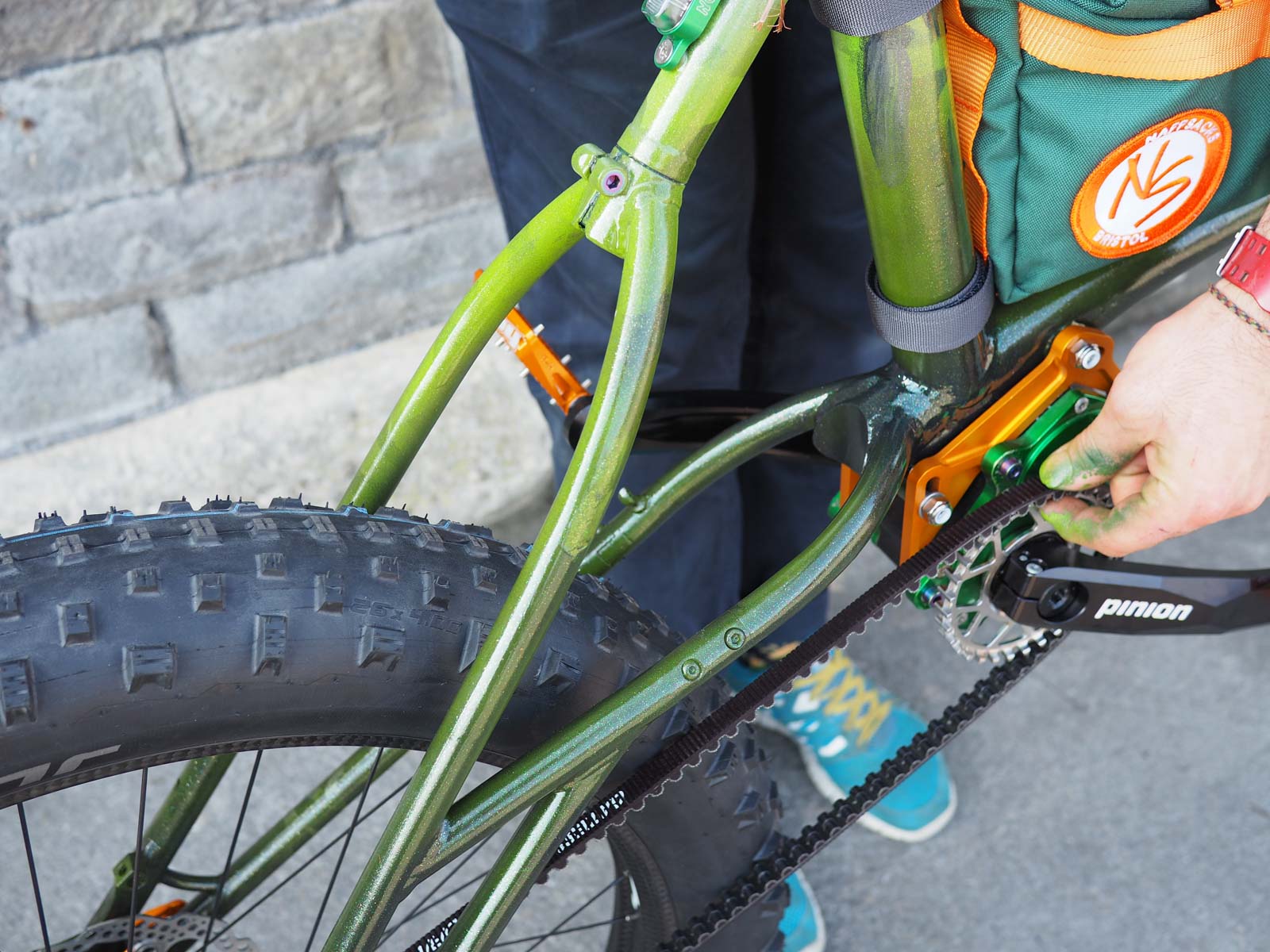
PETOR: It’s awesome because when you’re at the bicycle painting competition, “It’s about the bike, everyone, not just the paint!” Spray.Bike, and the story behind it is so nice. Garreth moved to Greece. Kids were building bikes out of junk because no one could afford anything because of the financial crisis. These kids are going to be rattle canning bikes no matter what, let’s give them something to work with. He worked with this spray paint company, one of the largest paint companies in the world, to develop this paint for kids who can’t afford paint to paint bikes with.
ANNA: And you can’t screw it up.
PETOR: It sticks to the bike.
ANNA: Plus, if it doesn’t hit the bike, it dries super fast and turns to dust, and you just sweep it up. It doesn’t get on anything else.
PETOR: Exactly. In spite of what the Bespoked security guards will tell you.
ANNA: It’s funny because you are so excited to talk about this bike, but you seem so nonchalant about the other bikes we talked about. Like you finish a bike and then you’re over it.
PETOR: I see success and failures in all of it. And I think that’s healthy. This is kind of what this film I’m making is all about. I’ve spent too much time at art school where you’re taught that it’s okay to fail. Now I run a small business and it’s not okay to fail, ever. When you’re always making something at the scale of prototype, it’s about rationalizing a thing and a thought process, and not just about churning out oa process for a customer.
The only real way of knowing what if is to figure it out. Go down the rabbit hole. And if your job is to consistently go down the rabbit hole, you will consistently fail. I always try to take the biggest risks on my own bikes because if I take the biggest risks and succeed, then I can take that risk with a customer’s bike. If I fail, there is nothing lost on my own bike.
ANNA: You can fix it.
PETOR: Or not. Or make another one that succeeds with there last one failed. I really feel like last year was a massive failure. From last year to the beginning of this year I just feel like a piece of shit. I don’t feel like I’ve done anything in the past year. I still haven’t finished the bike I took to Bespoked and it wasn’t finished. And I took it to Concourse of the Machines and it wasn’t finished. And then I rode it around all summer and it was awesome. And then I took it apart to sort out all the issues that were nibbling at me – but it’s just hanging in my workshop unfinished.
I’ve failed on that bike like three times now. The bike I took to Grinduro – I’ll bring that out to NAHBS to ride around on. It has a bunch of stuff on it that I’m just not happy with, which I’ve rectified and now it is amazing.
Taking big risks why being pushed for time, making stuff on the scale of a prototype with no tools in the dark – it’s not a good combination of things.
ANNA: No.
PETOR: I think I have good ideas. Of course I think I have good ideas, everyone thinks they have good ideas. But I do think I have good ideas. I’ve gotten a lot better at building things but I don’t feel like I can express myself in the way that I want to. It’s very frustrating, but in a way it is motivating.
ANNA: How do you want to express yourself beyond what you do now? I look at your bikes and they are all extremely expressive.
PETOR: There is stuff that is still just not what I want it to be. I’m not a perfectionist but –
ANNA: Can you just not push things far enough?
PETOR: Yeah. I need to learn Solidworks and how to 3D print stuff, which will give me so much more flexibility. I need to get a job that will give me money which will give me so much more flexibility. Where I am right now, and one thing that I’m extremely frustrated by, is that NAHBS is a really big thing for me because taking two weeks off is a big thing for me that I can’t afford to do ever. I’ve planned for this for a year, my builds for a year, so I could save up for this trip. I had some quite weird health problems over the summer and I couldn’t work really, and I’ve gotten back to schedule, slowly.
ANNA: You’re so isolated too. I mean, you’re working in the dark by yourself. You don’t live in a part of the world where you’ve got builders all over the place.
PETOR: If things are bad, I’ll call my friend Stuart who’s got a bike shop. If I feel really bad about things I’ll call Mike Burrows who will assure me that it’s actually much worse than I think it is.
ANNA: How nice!
PETOR: Which actually does cheer me up. I don’t know how I work. I’ve just been thrown out of my workshop, again.
ANNA: Again? What this time?
PETOR: I asked for electricity and the landlord said I was stressing him out too much. Before I moved in, all I asked for was somewhere that was on a ground floor with three-phase power that I wouldn’t have to move out of for five years. And it’s been none of those things.
ANNA: The last time I interviewed you, your houseboat had just sunk and you had just been kicked out of your London workshop.
PETOR: Yes. It was really hard because I didn’t have anywhere to move myself to because I didn’t have a house. I’ve just bought the back of a lorry from the 1950s and that’s going to be my workshop.
ANNA: Depending on the lorry, that could be awesome.
PETOR: I have to sell my lathe, but it’s never been hooked up. I actually put it under a lamp so when people visit the shop, they think I have machines. But I don’t. I have three hacksaws in case one breaks.
ANNA: You’re going to come to NAHBS, you’re going to get a lot of attention for this bike. It’s fresh and unusual. I haven’t seen anything like this. You take a lot of genres and then you slam them together in a really impressive way. It’s cool that you did it in steel and with lugs.
PETOR: I think it is harder to make a curvy steel bike than a curvy titanium bike. Titanium is a lot more ductile. It’s going to have a carbon seat tube as well.
It’s lugged because there is no point in going to America and telling jokes in Japanese.
ANNA: There are some fillet brazers in the states, but it isn’t as prevalent as it is here.
PETOR: I wanted to have the sort of double top tube and lugs and keep it real classic in the middle. Like Rivendell classic – so that the rest of it is so much more absurd. You know, the funny guy needs a straight guy to make him more funny.
ANNA: Like Sideshow Mel to Krusty.
PETOR: Exactly. You need the lugs to make the whole thing sillier. Also, I feel like I needed that to be – I’m not just an idiot smashing it together and not thinking about it. There is a lot of care and attention and thought that goes into it. But when you’re building something that’s borderline freak-bike, I don’t want it to be like this kind of bike club “oh yeah, we just had a room full of old bikes and we welded them together to make something cool” which is fine and it is good, but I’m just not that guy. I’ve been there and I’ve done that, but I do actually want to make something good which is rideable.
It’s got two sets of dropouts on the fork. On the show, we are showing it with 20in fat bike wheels. But someone is going to end up with this thing, and I want it to be rideable, so there is room for a 700x42mm. And the other side of dropouts on the fork, the trail is the same with the 700x42mm as it will with the 20in fat bike wheel. I do want to show people that I am actually good at this.
ANNA: What happens in the case where you come to the show and some kid walks up who has ever seen anything like your bike comes up to you, eyes like saucers, wanting to basically be you when they grow up. “I want to be the next Petor from Dear Susan.” What do you tell this person?
PETOR: That’s a rough question. I don’t know what I would tell them. I’d tell them to take PPE seriously.
ANNA: What’s ‘PPE?’
PETOR: Personal protective equipment.
Also, there is no rest for the weird kid. The road less trod is less trod for a reason. If a shortcut existed, it wouldn’t be a short cut. It would just be the way.
It depends so much on the person who is asking. If it’s some little kid, I’d be like, “Awesome! Go make some stuff and have fun!” I don’t imagine it would change their lives enough for them to do anything about it – there’s still hope for them.
But some kid who just finished some design course and doesn’t know what they are doing with their life I’d be like, “Yes, you should do this… after you’ve had a job for a few years and have saved enough money to support yourself without gainful employment, indefinitely.”
I don’t know how anyone does this. I don’t know how I do this. The support from the community is so important. It’s really tight-knit.
When I first went to the Bicycle Academy, there are these posters with words on them. It’s a pet hate for me.
ANNA: Inspirational posters.
PETOR: Yes. I hate them.
ANNA: They don’t speak to you.
PETOR: They do, but they don’t say anything nice.
One of them I hated at the time but now it talks to me, from The Bicycle Academy, said “flux is thicker than water.”
I was like, “Yeah, yeah factually is. Okay.”
But it really is. People really do stick together and look out for one another. That’s what makes this possible is community.
But really, asking my advice on something like that is really the blind leading the blind.
ANNA: See, I know builders who are horrified on a level when they learn they inspired another builder to start frame building. “Oh my god, I ruined that kid’s life!”
PETOR: That’s how I feel. There’s this amazing song by the Bonzo Dog Doo-Dah Band called “Bad Blood.”
This one eyed amputee is just trying to get revenge on this bad guy for this bad thing he’d done. He learns how to fight and becomes a cowboy – it’s a cowboy themed song. It’s kind of like the film El Topo. At the end of it he finds the bad guy. There’s a big bar brawl and someone else kills the bad guy. He’s like, “Look at what you’ve done! You’ve ruined everything! I spent seven years looking for this guy. I could have done anything with my life! I could have been a doctor or an architect!”
That’s how I feel about anyone wanting to become a frame builder. It’s exciting for awhile, and then the realities sink in, and then it’s like the final scene from The Graduate where they get on the bus and they look at each other. It’s not a look of “woohoo!”
It’s a look of, “Shit. Fuck. What did we just do? Fuck, we’ve just ruined our lives in a really short amount of time forever.”
ANNA: I feel like that’s a really great place to end.
PETOR: Well you don’t want someone getting to that point and then they realize that there is more to life than inhaling vaporized boric acid and silica fibers.
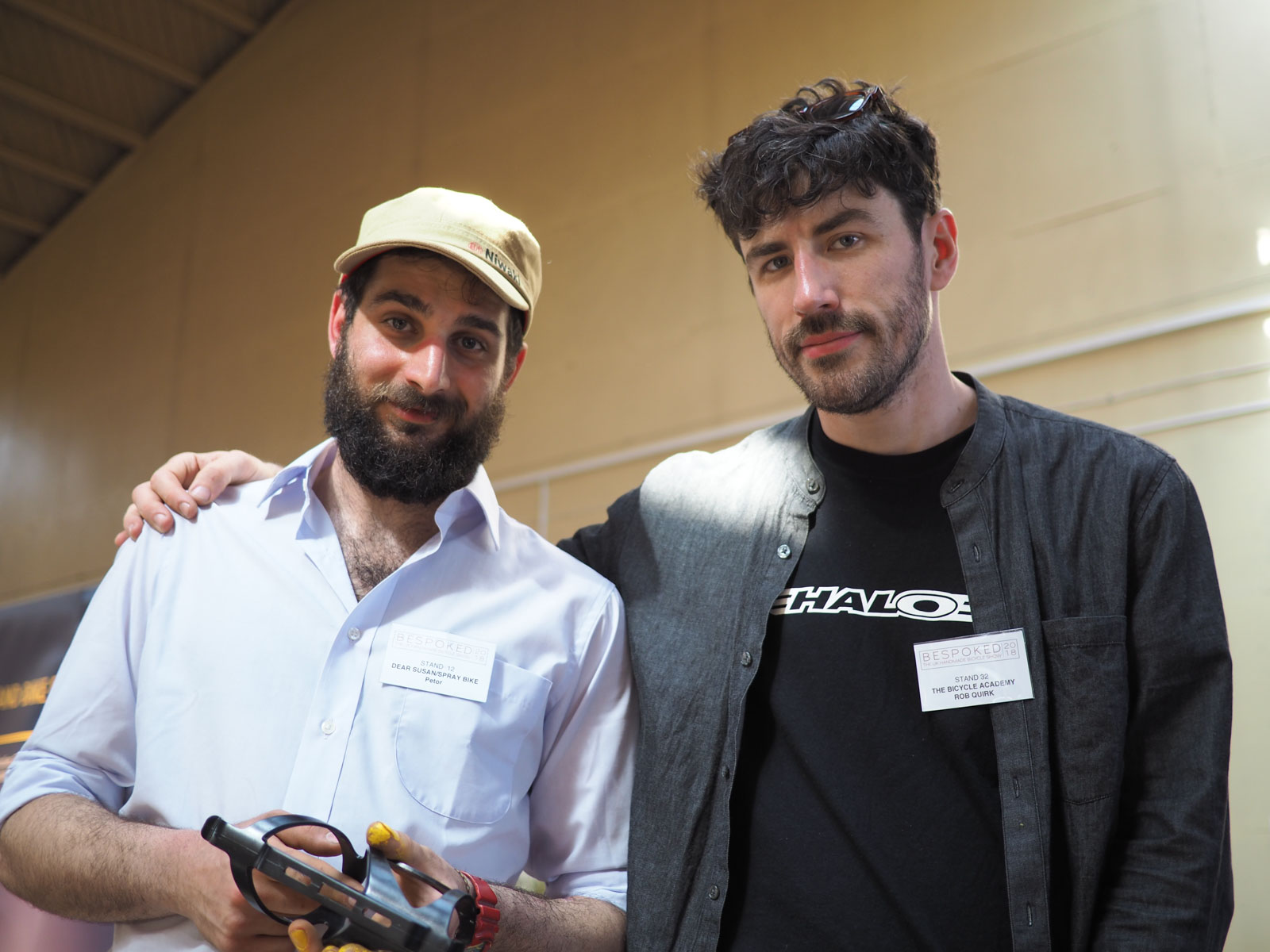
Thank you for reading! Be sure to visit Dear Susan at the North American Bicycle Show this coming Friday, Saturday, and Sunday in Sacramento, California, to see the final PUBESMOBILE product.
